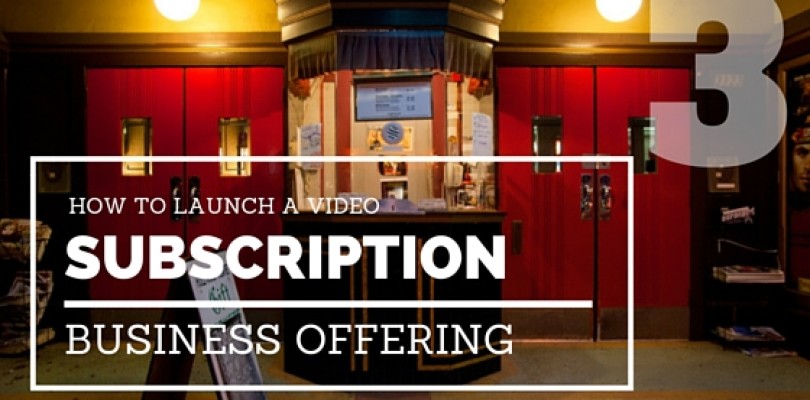As you figure out your content strategy and subscription offering, you need to map out how you will deliver your content to your viewers.
Your video subscription website is the foundation of your offering.
You want to make sure your website is easy for both you to use and your subscribers to navigate. The easier it is for you to manage the faster you’ll be able to add new content and manage your audience. For your subscribers, you want to offer an enjoyable experience that makes,it easy to purchase, view and search.
There are three key points to consider when creating a great subscriber experience:
- Create an easy to use site for you & your subscribers
- Make a good first impression & convert viewers to subscribers
- Engage subscribers & keep them coming back
Creating an Easy to Use Video Experience
Studies have shown that website visitors take mere seconds to determine if they want to continue to browse the site or go elsewhere. Your number one objective is to hook a visitor in and get them interested in your video content.Your branding and website should be set up to do just that. Here are the key factors that are important for your video website configuration.
SITE ACCESS
Site access determines how viewers get to your content and the environment in which they watch your videos. The option you pick depends on how your video subscription offering works. From completely open to restricted access, there are a number of ways you can build your video subscription website.
Public Site: Your video subscription site is open to anyone and optimized to be found in web search. Your videos can show up as results in search engines and your site provides open access to view the list of videos available once a visitor lands on that page. When a visitor views one of your videos, a Paywall form gates the video content and takes the person through a purchase flow. This format is best if you want viewers to see all of the content available for your subscription, you want the general public to subscribe and your content is not sensitive material such as internal corporate training. A public site environment also enables you to embed videos across the web while continuing to gate videos with a Paywall form.
Private Site with Paywall: In this situation, your videos are only available after a viewer has logged into a website. This can be accomplished using a login system on your video website or using a Single Sign On (SSO) integration if you already have a system or application with users. Once a user logs in, they are able to view the available videos and related information. To gain video access, an in-video Paywall form embedded in the video takes you through a payment flow.
Private Site: If you manage payment through a third-party system or if your video subscriptions are part of a larger package that is purchased outside the video site experience, you can use a private video website to provide your offering. Content is gated by a login page or SSO integration. This setup is optimal when video are complimenting another product or service that has been purchased.
Regardless of the type of site access you setup for users, you want to ensure that your subscribers can access content when and where they need it. This means a viewer should be able to watch their video subscription on every type of device including laptop, mobile, and tablet. Your video site technology should automatically optimize for these scenarios.
VIDEO PLAYER
In addition to creating a great video website, your video player will be instrumental in setting you up for success. A video player is the wrapper that goes around your video file. It’s what enables you to serve up your video for your viewers to watch. The player gives the viewer the ability to play the video, choose their resolution, share the video and more.
The player should also enable you to provide more functionality on top of the actual content. For example, you need an intelligent video player to offer and accept payment within the video. A modern player will also support video transcriptions, closed captioning and in-video interactivity, such as chaptering, links and calls-to-action, to engage your subscribers.
Your video player is also what enables you to understand how your subscribers engage with your content. An intelligent player will collect advanced analytics that allow you to determine if your video strategy is working. Make sure you can gather data about how your individual subscribers watch your videos and which parts of your videos are most popular.
The next blog in this series covers video analytics in more detail.
USER EXPERIENCE
When it comes to user experience, there are a two components you will want to be aware of and optimize for: search and flow.
Search
It must be easy for a subscriber to search and find relevant video content on your video subscription site. Use video meta data such as title, short description, long description, tags, categories and subcategories to organize your content. You can enhance your search by having a quality search toolbar that picks up keywords and phrases in your video description, related tags and transcripts.
Flow
The flow and guidance through your content should be easy to digest and not Overwhelming. Break up video content into digestible parts with video chaptering. Use playlists or related video suggestions to propose additional content. Keep categories and organization simple by sticking to a preset list of topics with very clear titles and descriptors. If you are organizing training related content, it may be helpful to list your sections into the phases of a product setup or title your video to answer one of the 5 W’s: Who, What, When, Where or How. Or use a ‘what’s in it for me statement’ in your video description.
TYPES OF INTERACTIVITY
- In-Video Links: Add links on top of your video that send viewers to external resources to supplement training videos with PDF documentation, websites for reference, etc.
- Comments, Drawing & Images: These tools enhance the video to emphasize specific content. This is great for recorded seminars or content from a lecture.
- Chaptering: Video chapters breakup longer content into easily digestible segments. From the table of contents, a subscriber can click thru to the content that is most meaningful to them.
- In-Video Quizzes: To reinforce information, you can engage your audience to complete a quiz before, during, or after they watch a video. You can also use quizzes as a method to survey and gather information from the subscriber such as feedback on what content to share or other data such as demographic information.
For you, video interactivity is a great way to gather valuable data about your subscribers.That’s why it’s very important that any in-video engagement be connected to your analytics. Knowing what people are clicking on and how they are watching your videos will help you continue to deliver content, increase revenue and maximize your ROI.

